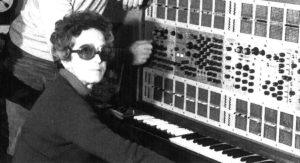Today, the quadraphonic piece Fluxus by Teresa Rampazzi will be performed during the final concert of the 50th Darmstadt Summer Course. After 70 years, Rampazzi is back at the Ferienkurse (she attended the course also in 1954, 1956, and until 1959, according to historical sources).
Wed, 11 August 2021, 19:30h, Sporthalle Lichtenbergschule
Final concert of the 50th Darmstadt Summer Course.
CONCERT PROGRAM
Teresa Rampazzi: Fluxus (1979) – 10’40”
Electronic Music
Rebecca Saunders: Dust III (2018-21) – 65′
World Premiere of the version for several percussion players
More details of the concert here (also in livestream): https://internationales-musikinstitut.de/en/ferienkurse/festival/programm/dust/

About Fluxus, 1979
Spatialization: 4-tracks
Published LP EDI-PAN PRC S 20-16, Roma, 1984.
Premiere: August 1979, Certaldo (Italy).
Original analogue tapes: Teresa Rampazzi Collection, University of Padua (Italy).
Digitization/restauration of the analogue tapes by MARTLab, Florence (Italy).
Fluxus was realized in 1979 with the use of the language ICMS (Interactive Computer Music System), a software created by Graziano Tisato at the CSC – Centro di Sonologia Computazionale at the University of Padova for the synthesis (connected to Music5 program, one of the early computer music programs), the editing and mixing, connected with a video, whose functions and algorithms were selected by means of a light pen. Teresa Rampazzi made the spatialization directly during the mixing of the 4-tracks. She preferred an acousmatic listening experience during concerts. Her musical works would thus be diffused without any further changes, because she disliked the human gesture in live electronic music.
From Teresa Rampazzi’s concert program [based on a citation by Heraclitus]:
«Fluxus was born from the ambitious desire to seek and find a form more adherent to the means we possess today for making music, both at the technological level and the vision of the world that together have required and caused the birth of these means. The computer suggests to us forms that cannot repeat any past, and that reflect our Heraclitean philosophy, where nothing can ever go back. The acoustic signals, therefore, flow one from the other and after the other, in an evolutionary process without interruptions. The [synthesis] technique of Frequency Modulation has been used here precisely to express, even at the level of the microstructure, this instability and incessant transformation that prevents any pause and, in a certain sense, already destroys the traditional concept of structure. Momentary shortcomings of hardware [an IBM System/7 computer system functioning in differed time] and software [the language ICMS – Interactive Computer Music System] prevented a more radical transformation of the signal and undermined the continuity of the form, which still suggests the flow of a river, sometimes slow, sometimes impetuous, sometimes dense, sometimes sparse. The parameters of density, rhythm, range of heights were therefore taken into consideration». Teresa Rampazzi, 1979.